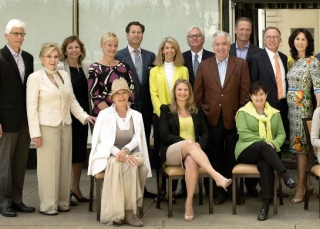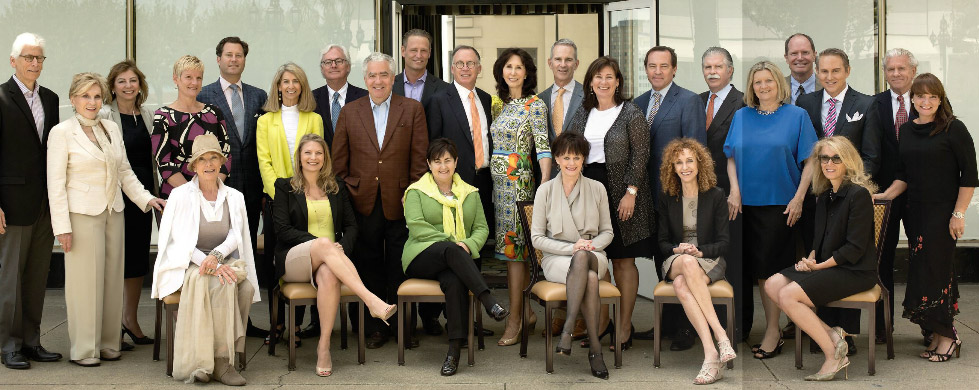Real Estate Round Table
September 09, 2014 Filed under: The Buzz

Top pros assess the housing market.
San Francisco housing is a bargain?
That was the consensus of more than two dozen of the region’s top real estate professionals attending a recent round-table luncheon at the Fairmont Hotel. Hosted by the Nob Hill Gazette and moderated by Rhonda Diaz Caldewey of Terranomics, this annual event offers a reliable barometer of the local housing market and a prescient prognosis of where the market is headed.
While no one was claiming that homes in the city are cheap or even affordable, many in the group pointed out that foreign buyers consider Bay Area prices a bargain compared to other world-class cities. These international investors are driving the residential market right now, attracted by the relatively lower pricing as well as the city’s schools and lifestyle.
Demand remains tight and the market drivers remain strong, attendees agreed. But the requirements of luxury buyers and the definition of luxury housing are much different than they were in the past.
The other main driver affecting price, of course, is the continued influx of technology workers. “Tech is absolutely driving this market,” one real estate veteran declared. Like their ex-pat counterparts, high-tech workers are primarily interested in brand-new, turnkey properties (especially in the south end of the city, where buses to Silicon Valley pick up residents last in the morning and drop them off first at night). Tech workers don’t care about finding a unique property or tackling a remodel—they want it all done already. “We used to talk about the hand-carved mantel,” one gentleman noted wistfully. “Now we talk about ‘walkability.’”
Supply and demand
The demand for this brand-new housing stock is outstripping supply, driving up prices, so that two surgeons can barely afford a house in Noe Valley anymore. But prices can only rise so high before buyers balk. These days, that magic number seems to be $8 million. Once you reach that figure, the group agreed, lines are no longer trailing out the door. In the East Bay, that top
figure is considerably lower.
At the same time that prices are rising, the concept of luxury has changed. There’s been a notable shift away from conspicuous consumption, as more and more buyers have been weaned on Pottery Barn and its ilk. Ostentation is not as important as convenience and livability for these buyers, who aren’t really shopping for a brick-and-mortar building anymore. They’re shopping for a lifestyle. It’s not the land the house sits on that matters; it’s the land that surrounds it—the parks, open spaces and trails.
And what of these tech workers’ parents? In the past, people used to abandon the city as they aged. But boomers are reversing that trend, trading life in suburbia for urban high-rises where all their needs can be taken care of and fine restaurants and cultural attractions are right outside their lobby door. With the rental market so hot, the roundtable experts pointed out, a lot of them are renting their old houses, not selling them—further contributing to a shortage in available product.
The price is right
So far this year, 80 percent of San Francisco homes sold for more than the asking price, compared to 65 percent last year. What’s more, 38 percent of sales are cash offers. That caused some in the group to wonder whether homes are actually priced too low.
“If you price where you think you should sell, it’s not going to sell,” said one longtime observer of the San Francisco real estate scene. “You need to price it strategically.” For this group, that meant pricing the property for less than they thought it would fetch, with the expectation that the actual sales price would be higher.
In fact, it was noted, the market is so efficient right now, that even if you didn’t put a price on a home, it would still sell for the appropriate amount.
What’s ahead?
The consensus among attendees was that while the current bubble is big, it also has a thick skin and will continue to grow. “The only time we saw a true correction was with the stock market crash,” one person noted. The group was bullish overall, and agreed that pricing would continue to rise for the next 12 months—or more. (One lone voice predicted prices would stabilize, instead.) That’s good news for sellers, and the real estate agents that represent them.
As for buyers … well, at least they can be grateful they’re not shopping for an apartment in Hong Kong.
Nob Hill Gazette, September 2014
by Fred Albert & Rhonda Diaz Caldewey
